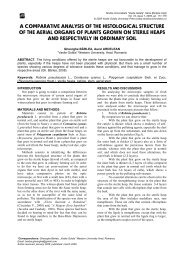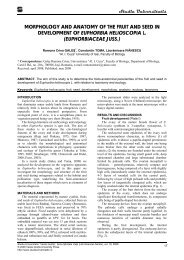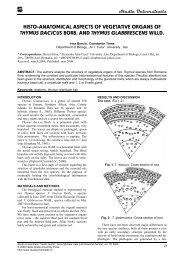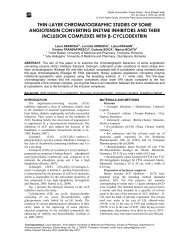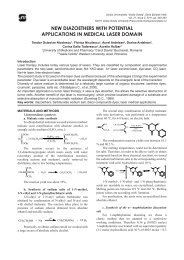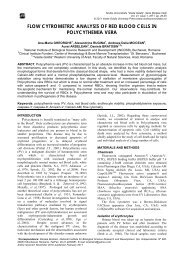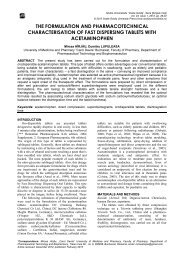Lacrajnan - Varghese - Studia Universitatis Vasile Goldis, Seria ...
Lacrajnan - Varghese - Studia Universitatis Vasile Goldis, Seria ...
Lacrajnan - Varghese - Studia Universitatis Vasile Goldis, Seria ...
Create successful ePaper yourself
Turn your PDF publications into a flip-book with our unique Google optimized e-Paper software.
<strong>Studia</strong> <strong>Universitatis</strong> “<strong>Vasile</strong> Goldiş”, <strong>Seria</strong> Ştiinţele Vieţii<br />
Vol. 22, issue 3, 2012, pp. 411-418<br />
© 2012 <strong>Vasile</strong> <strong>Goldis</strong> University Press (www.studiauniversitatis.ro)<br />
INTEGRATION OF ARTIFICIAL NEURAL NETWORKS<br />
INTO AN LINDENMAYER SYSTEM BASED PLANT<br />
MODELING ENVIRONMENT WITH MATHEMATICA<br />
SUHARTONO , Mochammad HARIADI , Mauridhi Hery PURNOMO<br />
1<br />
State Islamic University of Malang, Indonesia<br />
2<br />
Institute Technology Sepuluh Nopember Surabaya, Indonesia<br />
1 2 2<br />
ABSTRACT. Modeling of the plant growth can be visualized using the approach of Lindenmayer System (L-<br />
System). To make the condition close to the real environment characteristic, it is required the axiom and syntax<br />
grammar for the L-System. In this paper, we propose the use of artificial neural networks together with the L-<br />
System method, to model the plant's growth based on the current environment condition. At the beginning of<br />
plant growth, let the sprout of plant initially be denoted as axiom. This characteristic rules are illustrated in the<br />
reproduction of L-System also occur in nature of plant growth conditions based on the artificial neural networks.<br />
The software used in this modeling is Mathematica. In this research, the growth parameters value is given based<br />
on the artificial neural networks, the plant growth is visualized with the L-System method, and the 3-Dimension<br />
graph is shown as the virtual plant growth.<br />
Keywords: L-System, modeling, artificial neural networks, virtual plant growth, visualization<br />
INTRODUCTION<br />
reflected on plant growth as a virtual plant growth system.<br />
The modeling of plant growth is initialized by Aristid<br />
METHODS<br />
Lindenmayer, when he introduced the theory of anabaena<br />
Research is carried out at Multimedia and Networking<br />
catenula cell growth using the method called rewriting Laboratory, Institute Technology Sepuluh November.<br />
string. Later on, this rewriting string is known as the Some references on plant growth are also used. Some data<br />
Lindenmayer System (L-System) (Lindenmayer, 1990). is collected on the plant growth based on the extra<br />
Parallel rewrite systems or L-systems provide a useful inorganic fertilizer (Nitrogen(N), Phosphor(P) and<br />
formal model for the description of developmental Kalium(K)) and also organic fertilizer.<br />
processes in organisms. We will give some rudimentary This research used Zinnia Elegane Jacq, organic<br />
definitions for context-free L-systems with stacking fertilizer and inorganic fertilizer (Urea (N), Super Posfat<br />
capability. As it is in general very difficult to create an L- (P), KCl (K), POC NASA and Hormonik with<br />
system simulating some special growth process we will concentration 2 cc/l). Some tools are used, such as electric<br />
introduce supporting L-system (Jacob, 1995) inference. scale, leaf area meter, oven, termohigrometer and<br />
The development of L-System to explain the plant luxmeter. Sample data are taken from the plant after 26<br />
growth based on the environment condition can be seen days from transplating (HST). In this research, the amount<br />
on (Mech, 1996). It is then improved by (Prusinkiewicz, of fertilizer given varies. The field is in Karangploso,<br />
2003). L-System methods have been improved for Malang, East Java. The data collection is taken between<br />
modeling tools at many kinds of plant. The basic concepts Januarys until May 2011.<br />
of axiom and rules are the basis of how the growth of L- The hardware requirements used to model and<br />
System that works (Viruchpintu, 2005).<br />
visualize the plant growth is a personal computer with the<br />
At the beginning of plant growth, the sprout of plant specifications Intel Pentium Dual CPU 2.8 GHZ<br />
initially denoted as axiom. Let axiom be the sprout of Processor, RAM 1 Giga Byte, 100GB Hard drive, Graphic<br />
plant at the beginning of plant growth. This characteristic Card NVIDIA GeForce 8400GS.<br />
rules are illustrated in the further improvement of L- The Mathematica software under windows operating<br />
System that follows the plant growth naturally. It is the system is used in this research. Figure 1 shows the<br />
followed by the growth of stalk, branch, leaf and bloom. research methodology for Integration of Neural Networks<br />
The rule of plant growth is represented by the axiom. On into an L-System.<br />
the other hand, the value of axiom is generally generated In this research, the observations are carried out in 2<br />
using the probability (Atris, 2010). To make the axiom things, the plant growth itself and the environment. The<br />
value closer to the real environment condition, we plant growth observations are carried out by collecting<br />
propose the use of Artificial Neural Networks.<br />
data of the plant based on the height, the stalk diameter,<br />
This research is aimed to generate plant growth with L- leaf (which includes height, width and area), the bloom<br />
System method using the growth parameters is given diameter. On the other hand, the environment<br />
based on the artificial neural networks. Design of plant observations include putting different combination of<br />
growth used Mathematica programming (Heikki, 2009) fertilizer, temperature, weather, humidity and light<br />
on Windows Operating System. The output graphic on 3D intensity.
Suhartono et al.<br />
Fig. 1 The research methodology for Integration of artificial neural networks into an L-System<br />
RESULTS AND DISCUSSION<br />
geometry interpretation.<br />
Let us consider the following L-system: G<br />
The design of plant growth using L-System method<br />
Σ ={a,b,c,d,e}<br />
D0L-systems (D0 meaning: deterministic with no ω = abc<br />
context) are the simplest type of L-systems. Formally a<br />
P 1 a→bc<br />
P 2<br />
D0L-system L=(∑, α, P, T) , capable of encoding<br />
c→ae<br />
geometrical structures, consists of the following<br />
which generates the following sequence of strings:<br />
Axiom : abc<br />
ingredients: a) an alphabet ∑=(δ 1,…, δ n), each symbol of<br />
Iteration 1 : bcbae<br />
which stands for a morphological unit, like a sprout, a Iteration 2 : baebbce<br />
stalk, a leaf and a bloom b) a start string α, referred to as the Iteration 3 : bbccebbaee<br />
axiom, which is an element of ∑, the set of all finite words In this case, some samples of Zinnia Elegane Jacq<br />
over the alphabet ∑, c) P = (p ,…, p ), a set of productions plant, Figure 7 shows an example L-system describing<br />
1 n<br />
or rewrite rules, d) a geometrical interpretation T , a 3D growth sequences of sprouts, leaves and blooms of<br />
semantics, for some of the symbols from ∑, translating a virtual plant, together with its graphical interpretation.<br />
string into a spatial structure, i.e. special symbols represent<br />
The D0L-system encodes turtle geometry macros for<br />
generating graphical representations of the leaves,<br />
commands to draw graphic objects like points, lines,<br />
blooms and stalks in Figure 2.<br />
polygons etc; this translation is commonly known as turtle<br />
Fig. 2 Example of parameterized D0L-System modeling Zinnia Elegane Jacq stages of plantlike structure<br />
412 <strong>Studia</strong> <strong>Universitatis</strong> “<strong>Vasile</strong> Goldiş”, <strong>Seria</strong> Ştiinţele Vieţii<br />
Vol. 22, issue 3, 2012, pp. 411-418<br />
© 2012 <strong>Vasile</strong> <strong>Goldis</strong> University Press (www.studiauniversitatis.ro)
Integration of artificial neural networks<br />
into an lindenmayer system based plant<br />
modeling environment with mathematica<br />
longitudinal, lateral, and vertical axes is rl (roll left), rr<br />
(roll right), pu (pitch up), pd (pitch down), yl (yaw left)<br />
and yr (yaw right) in Table 1, thus translating a one-<br />
dimensional string into a 3D geometrical object<br />
resembling a plant (some of these commands do not occur<br />
in the example L-system).<br />
The D0L-System encodes turtle geometry macros for<br />
generating graphical representations of the leaves,<br />
blooms and stalks. An each symbol, f represent<br />
commands to move forward the turtle, b represent<br />
commands to move backward the turtle and change the<br />
drawing tools orientation by rotation around its<br />
Symbol<br />
of<br />
string<br />
FO[s]<br />
PU(α)<br />
PD(α)<br />
RR(α)<br />
RL(α)<br />
YR(α)<br />
YL(α)<br />
Turtle Rules for Interpreting 3D<br />
Description<br />
Advances the turtle by a step size of s<br />
in the direction and draws a line<br />
depending on the current color and line<br />
thickness settings.<br />
The turtle is tilted up around its<br />
transverse axis y by an angle of α<br />
degree.<br />
The turtle is tilted down around its<br />
transverse axis y by an angle of α<br />
degree.<br />
The turtle is rotated right (clockwise)<br />
around its longitudinal axis x by an<br />
angle of α degrees.<br />
The turtle is rotated left (clockwise)<br />
around its longitudinal axis x by an<br />
angle of α degrees.<br />
The turtle is rotated right (clockwise)<br />
around its vertical axis Z by an angle of<br />
α degree.<br />
The turtle is rotated left<br />
(counterclockwise) around its vertical<br />
axis Z by an angle of α degree.<br />
Table 1<br />
The kLSystems package in MathEvolvica (Jacob,<br />
1995) contains definitions for the application of parallel<br />
rewrite rules of L-Systems with left and right contexts<br />
with arbitrary length. Each rule of the form l < p > r → s as<br />
described above is represented by a Mathematica<br />
expression of the form<br />
LRule[ LEFT[ l ], PRED[ p ], RIGHT[ r ], SUCC[ s ] ].<br />
Accordingly, we define the production set as an<br />
LRULES expression<br />
LRULES [ LRule[...], LRule[...], ... ]<br />
and an L-system is described as follows:<br />
LSystem[ _AXIOM, LRULES[ __LRule] ]<br />
With this representation we can easily derive the type<br />
of the expressions and sub expressions by only looking at<br />
sprout symbols. Application kLSystems package in<br />
MathEvolvica at plant growth of Zinnia Elegane Jacq<br />
(Lydia, 1998).<br />
<strong>Studia</strong> <strong>Universitatis</strong> “<strong>Vasile</strong> Goldiş”, <strong>Seria</strong> Ştiinţele Vieţii<br />
Vol. 22, issue 3, 2012, pp. 411-418<br />
© 2012 <strong>Vasile</strong> <strong>Goldis</strong> University Press (www.studiauniversitatis.ro)<br />
The Integration Of L-System and Artificial Neural<br />
Networks<br />
Here, the artificial neural networks is used to explain<br />
input/output relationship for a non linear model. This<br />
input/output relationship is generally the<br />
interconnections among various elements of a growing<br />
structure and the environment. The Neural Networks<br />
output is used as values for the growth parameter, such as<br />
various elements of a growing structure which are sprout,<br />
stalk, leaf and bloom.<br />
The experiment is conducted to the plant growth of<br />
Zinnia Elegane Jacq with various kinds of treatments.<br />
As an example, treatment 1 is without any fertilizers.<br />
Treatment 2 is with no organic and 50% amount of<br />
inorganic, and so on. The amount of fertilizer that suits<br />
the plant growth will generate the growth parameter, as<br />
shown in Table 1.<br />
413
Suhartono et al.<br />
Growth Parameter from the treatment of various amount of fertilizer given to Zinnia Elegane Jacq Table 2<br />
Code<br />
Growth Parameter<br />
Stalk Leaves<br />
High High<br />
(cm) (cm)<br />
Leaves<br />
Width<br />
(cm)<br />
Bloom<br />
Diameter<br />
(cm)<br />
Plant<br />
High<br />
(cm)<br />
1 8,3 9,9 5,7 18,7 51.2<br />
2 9,4 10 5,7 19 55<br />
3 10 10,4 5,8 21,1 55<br />
4 9,3 10,3 5,8 23,3 51.8<br />
5 9,2 10,1 5,8 20,7 55<br />
6 10,9 10,4 6 19,2 58.2<br />
7 11 10,4 6 23,2 55<br />
8 11 10,5 6,1 25 55<br />
9 11,4 10,7 6,2 26,7 61.5<br />
10 11,6 11 6,2 27,8 58.2<br />
11 11,8 11,1 6,2 27 58.2<br />
12 12 11,2 6,2 28,9 60.9<br />
13 12,4 11,3 6,3 29,2 61.5<br />
14 12,5 11,4 6,6 31 61.5<br />
15 12,7 11,4 6,6 31 61.5<br />
In this observation, the measurement of plant growth<br />
is divided into two parts: a). 15 data is used as the<br />
parameters for the learning in the artificial neural<br />
networks, as in table 1, b). 5 data is used as the comparator<br />
to the output of artificial neural networks (test data).<br />
The modeling of artificial neural networks with<br />
Mathematica software is using 2 variable inputs which<br />
are combination of inorganic fertilizer and organic<br />
fertilizer, and one output which is the growth parameter<br />
(Stalk Height, Leaves Height, Leaves Width, Bloom<br />
Diameter, Length Branch, Number of Branch, Number of<br />
Bloom, and Plant Height). The input and output vectors<br />
of the architecture artificial neural networks are shown in<br />
figure 3.<br />
Fig. 3 A two-input and one-output network with three hidden layer.<br />
This network architecture takes a pattern of inputs and creates a binary output.<br />
414 <strong>Studia</strong> <strong>Universitatis</strong> “<strong>Vasile</strong> Goldiş”, <strong>Seria</strong> Ştiinţele Vieţii<br />
Vol. 22, issue 3, 2012, pp. 411-418<br />
© 2012 <strong>Vasile</strong> <strong>Goldis</strong> University Press (www.studiauniversitatis.ro)
Integration of artificial neural networks<br />
into an lindenmayer system based plant<br />
modeling environment with mathematica<br />
Individual processing elements receive inputs from<br />
many other processing elements (x i) via weighted<br />
connections. We can get the dimensions of the input and<br />
output vectors from the architecture artificial neural<br />
networks , the input is the first element, the desired output<br />
is the second element. We can set the size of the artificial<br />
neural networks.<br />
In this figure 5, every processing element receives<br />
one or more inputs (x i) via weighted connections (α hidden).<br />
The initial set up in this research, the artificial neural<br />
network requires 2-element input (organic fertilizer and<br />
inorganic fertilizers), 3 hidden elements and a single<br />
output (that's called stalk). From the 3 elements hidden<br />
layer, it will be obtained the weights of the inputs to the<br />
hidden layer and the weights of the hidden layer to the<br />
output layer.<br />
These weighted inputs (αhidden.<br />
x i) are summed and the<br />
threshold value (θ j) is then added, generating a single<br />
activation level for the processing element (h hidden).<br />
hhidden<br />
= ĺ a<br />
hiddenixi<br />
+ q<br />
j<br />
This activation level constitutes the argument of a<br />
transfer function , sigmoid function as in Listing 7. This<br />
function then generates the node output . This output is<br />
passed to the weighted input connections of many other<br />
processing elements. This process is shown for node j in<br />
Figure 4.<br />
Fig. 4 Operation of a typical processing element.<br />
The Back-propagation networks is the network type propagation method, and Training Set function within<br />
most suited to forecasting (Niklas, 1986). The expected Mathematica is used (Freeman, 1994). The high level<br />
relation is “learned” by repeatedly presenting samples of code to run the overall 'artificial neural network' system<br />
the expected input/output relationship to the network and that is already developed, is shown in Listing 1. In this<br />
adjusting the model parameters (i.e. the connection code, it runs with 12500 at organic fertilizer 0 and<br />
weights) in order to get the best possible match between inorganic fertilizer 50. For the first 12500 of running this<br />
the historical values and those generated by the model. code, the epoch size is plotted as seen in Figure 5. The test<br />
To present the training set of input (organic fertilizer result of the program is shown in Listing 2.<br />
and inorganic fertilizers) and stalk output using the back<br />
List. 1 The code of running it through our network with 12500 at organic fertilizer 0 and inorganic fertilizer 50<br />
<strong>Studia</strong> <strong>Universitatis</strong> “<strong>Vasile</strong> Goldiş”, <strong>Seria</strong> Ştiinţele Vieţii<br />
Vol. 22, issue 3, 2012, pp. 411-418<br />
© 2012 <strong>Vasile</strong> <strong>Goldis</strong> University Press (www.studiauniversitatis.ro)<br />
415
Suhartono et al.<br />
Fig. 5 First 12500 iterations we get the following error<br />
List. 2 The code of the results for the testing at stalk<br />
The output of the artificial neural networks is then<br />
compared to the actual data of plant growth in the field.<br />
From this figure 6, it can be seen that the difference<br />
between artificial neural networks output and the actual<br />
plant growth is less than 6% on average.<br />
Fig. 6 The comparison of simulation and actual output.<br />
416 <strong>Studia</strong> <strong>Universitatis</strong> “<strong>Vasile</strong> Goldiş”, <strong>Seria</strong> Ştiinţele Vieţii<br />
Vol. 22, issue 3, 2012, pp. 411-418<br />
© 2012 <strong>Vasile</strong> <strong>Goldis</strong> University Press (www.studiauniversitatis.ro)
Integration of artificial neural networks<br />
into an lindenmayer system based plant<br />
modeling environment with mathematica<br />
Based on the output of the artificial neural networks, method of the artificial neural networks. In order to<br />
it can be derived the growth parameter. It is then applied visualize the plant, the virtual growth of Zinnia Elegane<br />
to the plant, in such a way that it is possible to get the crop<br />
th<br />
Jacq with the 5 treatment (75% inorganic and organic<br />
as expected. Once the stalk growth is obtained, then the fertilizer is 100%) is shown in figure 7.<br />
leaf and bloom growth need to be found using the similar<br />
Fig. 8 Growth processes of Zinnia Elegane Jacq plant of Iteration 7<br />
CONCLUSION<br />
REFERENCES<br />
This research shows that the Integration of the Lindenmayer, P. Prusinkiewicz. The Algorithmic Beauty<br />
artificial neural networks into L-system based Plant of Plants, Springer Verlag, New York, pp. 227,<br />
modeling Environment has been implemented. In this 1990.<br />
research, it can be demonstrated that the difference Jacob, C., Genetic L-System Programming: Breeding and<br />
between the artificial neural networks output and the<br />
Evolving Artificial Flowers with Mathematica,<br />
actual plant growth is less than 6% on average. It is<br />
First Int. Mathematica Symposium, Southampton,<br />
concluded from this research that the agriculture of Zinnia UK, Computational Mechanics Pub, 1995<br />
Elegane Jacq plant could be develop further with the R. Mech, P. Prusinkiewicz. Visual Models of Plants<br />
artificial neural networks, which both controlled<br />
Interacting with Their Environment, Proceedings<br />
environment and controlled mixture of fertilizer are used of SIGGRAPH 96, ACM SIGGRAPH, p. 397,<br />
as decision support system. 1996.<br />
<strong>Studia</strong> <strong>Universitatis</strong> “<strong>Vasile</strong> Goldiş”, <strong>Seria</strong> Ştiinţele Vieţii<br />
Vol. 22, issue 3, 2012, pp. 411-418<br />
© 2012 <strong>Vasile</strong> <strong>Goldis</strong> University Press (www.studiauniversitatis.ro)<br />
417
Suhartono et al.<br />
R. Viruchpintu, N. Khiripet. Real Time 3D Plant<br />
Structure Modeling by L-System with Actual<br />
Measurement Parameters, National Electronics<br />
and Computer Technology Center, Bangkok,<br />
2005<br />
Atris Suyantohadi, Alfiyan, Mochamad Hariadi,<br />
Mauridhi Hery Purnomo. Plant Growth<br />
Modelling Using L-System Approach and Its<br />
Visualization, Jurnal Makara , Teknologi, Vol. 14,<br />
NO. 2, pp. 92-96, 2010.(In Indonesian).<br />
Heikki Ruskeepaa. Mathematica Navigator, Elsevier Inc,<br />
2009.<br />
Jacob, C. MathEvolvica - Simulierte Evolution von<br />
Entwicklungs programmen der Natur, PhD<br />
dissertation , Arbeitsberichte des Instituts für<br />
m a t h e m a t i s c h e M a s c h i n e n u n d<br />
Datenverarbeitung, Band 28, Nummer 10,<br />
Erlangen, 1995. .(In Deutch Language).<br />
Lydia Kristi, Nurhajati Ansori. Pengaruh Dosis Dan<br />
Waktu Pemberian Uniconazole Terhadap<br />
Pertumbuhan Dan Pembungaan Kembang Kertas<br />
(Zinnia Elegane Jacq.), Buletin. Agr. Vol. XX.<br />
No.1 , 1998.(In Indonesian).<br />
Niklas, K.J. Computer-simulated Plant Evolution, in:<br />
Scientific American, 254 (March), pp. 68-75,<br />
1986.<br />
Freeman, JA. Simulating Neural Networks with<br />
Mathematica, Journal Mathematica Addison-<br />
Wesley, Reading MA, 1994.<br />
418 <strong>Studia</strong> <strong>Universitatis</strong> “<strong>Vasile</strong> Goldiş”, <strong>Seria</strong> Ştiinţele Vieţii<br />
Vol. 22, issue 3, 2012, pp. 411-418<br />
© 2012 <strong>Vasile</strong> <strong>Goldis</strong> University Press (www.studiauniversitatis.ro)



